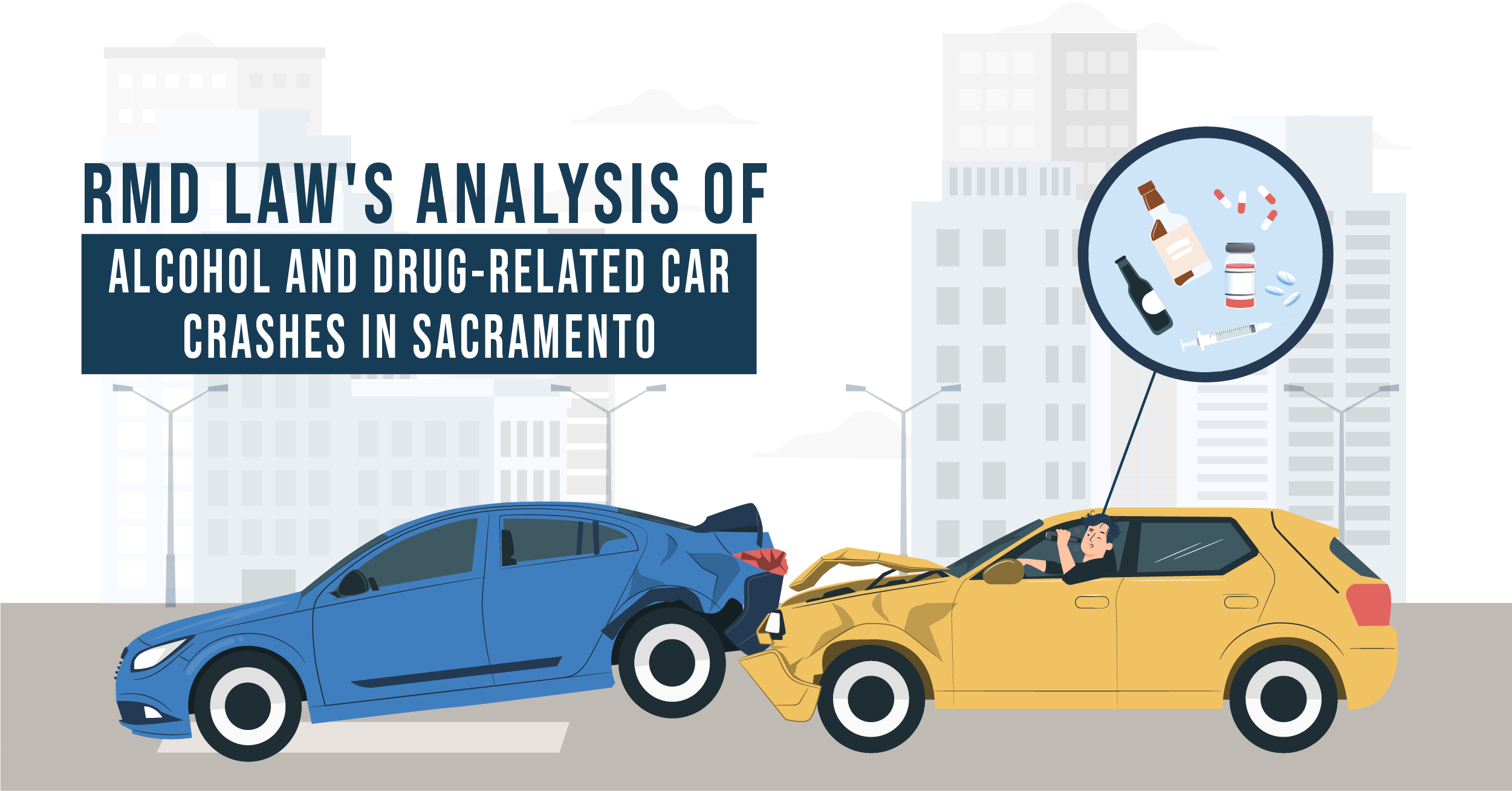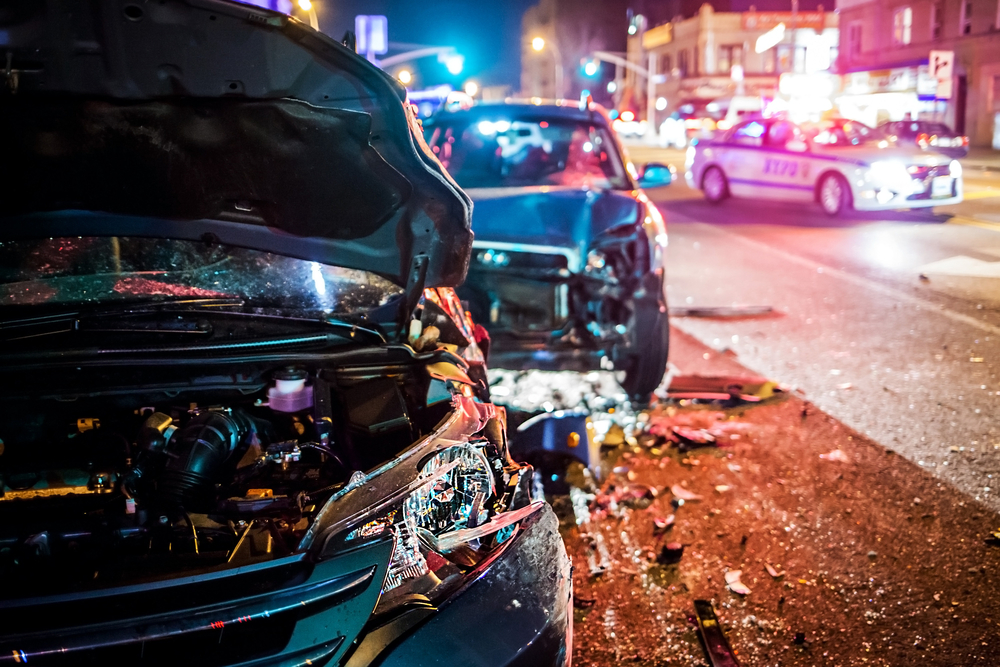
As a responsible driver, it’s your duty to keep the roads safe for fellow motorists and pedestrians. This includes not going behind the wheel while under the influence of alcohol and drugs. Unfortunately, many drivers ignore this and risk getting into car crashes that endanger many lives and damage private and public properties.
Alcohol and drug-related car crashes in Sacramento, California, continue to be a concern, but amidst the troubling statistics, there’s a glimmer of hope in government policies like Vision Zero. This action plan outlines the city’s efforts to eliminate traffic fatalities and serious injuries by 2027.
In this article, we’ll delve into the latest statistics surrounding alcohol and drug-related car crashes in Sacramento. More importantly, we’ll explore the steps you can take to lower these numbers and make the roads safer for everyone.
12 Alcohol and Drug-related Car Crashes in Sacramento Facts and Figures
Here are some statistics on Sacramento car accidents, including alcohol and drug-related incidents across the United States.

- 26% of driving deaths in Sacramento involve alcohol
- An average of three alcohol-related car crashes occurred in Sacramento in 2021 and 2022. In each of the last two years, 60 people died, an increase from the average of about 50 fatalities annually eight years prior.
- The road intersections in Sacramento that see the most alcohol-related car crashes include:
a. Stockton Boulevard and Florin Road
b. Florin Road and Franklin Boulevard
c. Fruitridge Road and Franklin Boulevard
d. Auburn Blvd and Watt Avenue
e. Antelope Road and Walerga Road

- Over 54% of drivers injured or killed in traffic crashes in the US had one or more drugs or alcohol in their bloodstream.
- In 2021, 27% of drivers aged 15–20 who died in a car crash had a blood alcohol concentration of .01 g/dL or higher.
- Men are more likely to be involved in an alcohol-related crash, with four male drunk drivers for every female drunk driver.
- Among vehicle types, motorcycle operators involved in fatal accidents displayed the highest percentage (28%) of alcohol-impaired drivers.
- About 10,850 people died yearly in drunk-driving crashes from 2012 to 2021. In 2021 alone, 13,384 died in preventable car crashes.
- Drivers involved in fatal accidents who had blood alcohol concentrations of.08 g/dL or above were four times more likely to have previous convictions for intoxicated driving.
- One person died in a drunk-driving crash every 39 minutes in the US in 2021.
- An average of 29 people in the US die in alcohol-related car crashes daily.
- In 2021, more alcohol-related fatal crashes happened in July (9.7%) and August (9.6%) than in any other month, with the summer season seeing a higher incidence of these accidents.
5 Types of Alcohol and Drug-related Car Crashes
Alcohol and drug-related car crashes come in many different types, but they all have one thing in common: they’re preventable. Here are the types of alcohol and drug-related car crashes you should know.
1. Impaired driving crashes
When drivers are under the influence of alcohol or drugs, they experience impaired judgment, slowed reaction times, and reduced coordination, all of which increase the likelihood of accidents. These crashes can vary in complexity, involving multiple vehicle collisions or a single vehicle crashing into trees, utility poles, or guardrails.
Impaired driving is a leading cause of road accidents and can result in severe injuries or fatalities.
2. Single-vehicle crashes
From the name itself, single-vehicle crashes involve just one car and typically occur when a driver loses control due to impairment from alcohol or drugs and becomes unaware of their surroundings. These accidents can be fatal due to a vehicle striking fixed objects, such as trees, utility poles, or guardrails, or when it rolls over.
The outcome of single-vehicle crashes can be severe, especially if the driver is impaired and not wearing a seatbelt. It often leads to injuries and fatalities.
3. Pedestrian and cyclist accidents
Road incidents involving pedestrians and cyclists are especially concerning when alcohol or drugs impair a driver’s judgment, coordination, and reaction time. This makes it more common for them to make mistakes on the road, such as driving too fast or not paying attention to their surroundings.
Additionally, pedestrians and cyclists are often smaller and less visible to the driver than motor vehicles. This vulnerability makes it more difficult for alcohol- or drug-impaired drivers to see them, especially at night or in poor weather conditions.
4. Rollover accidents
This type of accident involves a vehicle overturning onto its roof or side due to erratic driving behaviors, such as excessive speeding or sudden steering maneuvers.
Rollover accidents can be classified as:
- Tripped rollovers – a car tips over after hitting something, like a curb or another object
- Untripped rollovers – a vehicle tips over because of its movements, like sharp turns or sudden maneuvers
These accidents are hazardous as vehicles can sustain substantial damage during rollovers, injuring the drivers or passengers inside, aside from the pedestrians that may be affected.
5. Hit-and-run crashes
Hit-and-run crashes occur when a driver involved in an accident flees the scene without stopping to exchange information or offer assistance to the other affected parties. Impaired drivers may choose to leave the scene due to fear of legal consequences, making it difficult to identify and hold them accountable.
These incidents can lead to injuries or fatalities, further complicating the legal process for victims seeking compensation and justice.

How to Avoid Alcohol and Drug-related Car Crashes
Alcohol and drug-related car crashes are a major problem, causing severe injuries and even death. In some cases, they can also lead to personal injury lawsuits. Follow the tips below to avoid them and save yourself from serious physical, mental, and legal implications.
1. Plan your transportation
Make responsible decisions before you start drinking or taking medication that may impair your ability to drive safely. Consider your transportation options and arrangements to ensure you have a safe way to get home. For instance, leave your car at home to avoid the temptation of driving under the influence. Instead, take public transportation or carpool with a sober friend.
If your initial plans fall through or unexpected situations arise, know the location of nearby hotels or places where you can safely spend the night. This proactive approach reduces the likelihood of making impaired decisions later on, putting your and others’ lives in danger.
2. Get a ride home
Getting a ride home is a straightforward and effective way to avoid driving under the influence of alcohol or drugs. Utilize rideshare services, taxis, or public transportation when you’re impaired. You can also ask a sober friend or family member to pick you up. Any of these choices protect you and others from potential alcohol- or drug-related accidents.
3. Assign a trusted designated driver
Select a designated driver from your group who will commit to staying sober and driving everyone home safely. This ensures that a sober individual will control the vehicle, reducing the risk of impairment-related accidents.
4. Never get in a car with a driver who has been drinking
Prioritize your safety by refusing to ride with a driver who has consumed alcohol or drugs. Even if you haven’t been drinking yourself, riding with an impaired driver puts your and others’ lives at risk. Encourage them to find an alternative way home, such as a designated driver or rideshare service.
5. Be aware of prescriptions and over-the-counter medicines
Many prescription and over-the-counter meds impair your ability to drive safely. Read labels carefully and consult your healthcare provider to understand potential side effects. If a medication affects your driving, explore alternative transportation options.
Moreover, avoid taking certain medications with alcohol as it can make the drug toxic to your body or less effective. Alcohol can also make the side effects worse.
6. Always wear a seat belt on every trip
Wearing a seat belt is one of the simplest yet most effective ways to protect yourself in any vehicle. According to the National Highway Traffic Safety Administration (NHTSA), 50% of passengers who died in car crashes in 2021 didn’t use a seatbelt.
Seat belts significantly reduce the risk of injury or death in a car accident, including those caused by impaired drivers. Always buckle up, regardless of the length of your trip or your role as a driver or passenger.
Stay Safe on the Road
While some car crashes are unexpected, those caused by alcohol and drug use are completely preventable. Follow the tips above to keep yourself and others safe on the road. Moreover, encourage your friends and family members to be responsible drivers. The consequences of a DUI are never worth it.
If you’ve been involved in an alcohol and drug-related accident and need an attorney to guide you, contact us at RMD Law. We have a team of experienced car accident lawyers in Sacramento ready for the tireless representation you deserve.
Contact us for a free case evaluation.
- Car Accidents in San Francisco County: Statistics, Intersection Data, and More - March 1, 2024
- 7 Things Covered Under the Good Samaritan Law in California - February 29, 2024
- California Wrongful Death Law: What Is It and How to File A Claim - February 21, 2024

